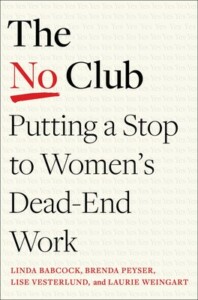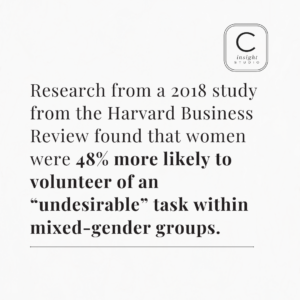My personal takeaways after reading “The No Club: Putting a Stop to Women’s Dead-End Work”

A couple years ago, I attended a women’s executive leadership program at UC Berkeley. Besides learning from the high caliber professors, it was enlightening (and validating) to hear how many of the women in our cohort faced similar challenges in the workplace.
One of the things we talked about is how overwhelming work can get. It turns out that a big part of this stress comes from women being asked to take on a lot of “non-promotable work.” What is non-promotable work you ask?
This type of work is important for an organization but doen’t directly contribute to the bottom line or have a positive impact on an individual’s career. It’s sometimes referred to as “office housework” —things like organizing office events, helping coworkers behind the scenes, and handling various logistical duties. These are important for keeping the workplace running smoothly but can take a lot of time and effort away from your core priorities.
Without knowing it, taking on too many of these types of tasks not only contributes to feeling overwhelmed but it takes time away from other higher value work. One of the recommended reads as a follow up to this topic was a book called The No Club: Putting a Stop to Women’s Dead-End Work.
This book got my attention because I’m no stranger to accepting and subsequently managing too many work requests. While I fundamentally know it’s important to prioritize higher impact initiatives, overcommitting to low-impact work makes this challenging.
This is especially true when saying YES is associated with being a team player — and doubly true when you are a woman working to level the playing field. Research from a 2018 study from the Harvard Business Review found that women were 48% more likely to volunteer for an “undesirable” task within mixed-gender groups.
I had a work friend once say it was like “death by a thousand cuts.” When you feel buried from a mountain of time consuming tasks, discerning what to say no to (and how to do it without creating negative backlash) feels insurmountable.
This book not only sheds light on why doing non-promotable work is problematic for women in particular, but offers practical tips on how to identify it when it happens and how to handle scenarios in which it’s best to say no.
The Yes-No-Yes Strategy
 One great takeaway from the book was the “Yes-No-Yes Strategy”. This is a recipe for how to respond with a “positive no”, which considers your needs while safeguarding office place relationships. The key is to respect yourself and the other person. It goes like this:
One great takeaway from the book was the “Yes-No-Yes Strategy”. This is a recipe for how to respond with a “positive no”, which considers your needs while safeguarding office place relationships. The key is to respect yourself and the other person. It goes like this:
- A person asks you to do something that doesn’t align with your role, priorities, or you don’t have time to do.
- First, say yes to yourself by recognizing and expressing your needs, priorities and values.
- Say no to assert your agency and personal power. You may simply give a brief explanation and keep your reasoning to yourself.
- Then, say yes to helping the person get the support they need by suggesting other people or resources who can help them. For example: “I’m going to have to decline, but X person would be a good resource to help you!” Suggest someone who isn’t overburdened and has the right skill set to support the request.
Here are a few additional pointers to help you follow through on the Yes-No-Yes Strategy.
- Keep in mind that when you get asked to take something on you aren’t sure about, you don’t have to provide an answer right away. Take a minute to think about what the impact would be if you said yes. Would other critical work not get done? Is this truly something you should do?
- Ask the requester to clarify why they want you to do the task. Knowing this will help determine alternative resources to recommend.
- Cultivate support with other women to help you evaluate opportunities. It doesn’t have to be a formal “No club” but it is helpful to have a sounding board if you are routinely asked to do tasks that don’t align with your core priorities.
- If it’s a request from your manager, you can ask what other priorities may need to shift in order to take this new task on.
- The key to a firm “no” is to be clear, concise and airtight.
- While you can’t and don’t want to say no to everything, having more awareness is key. The mindset shift is to go from accepting everything without thinking about the impact to being more intentional about what you say yes to.
Here’s a video by the authors of the book that explains the Yes-No-Yes strategy. There are more helpful tips in the book for both employees and managers. If you are a manager, it’s important to be aware of this tendancy so you can also watch out for it and balance the workload more fairly. That may be a follow up blog post!
If you are struggling with overwhelm, feel free to book a complimentary mentor session to learn how to spot non promotable tasks and how to say no without negative backlash.
Thanks for reading!




This is valuable for me, especially as a leader, because I want to make sure that my team feels valued, and valuable.
So glad. A sign of a great leader!